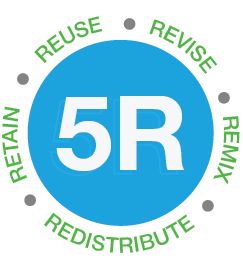 |
What does it mean for a learning resource to be "open"? The 5R framework, proposed by David Wiley, defines the major characteristics of "open" content.
Retain
the right to make, own, and control copies of the content
Reuse
the right to use the content in a wide range of ways (e.g., in a class, in a study group, on a website, in a video)
Revise
the right to adapt, adjust, modify, or alter the content itself (e.g., translate the content into another language)
Remix
the right to combine the original or revised content with other open content to create something new (e.g., incorporate the content into a mashup)
Redistribute
the right to share copies of the original content, your revisions, or your remixes with others (e.g., give a copy of the content to a friend)
This material was created by David Wiley and published freely under a Creative Commons Attribution 4.0 license at: http://opencontent.org/blog/archives/3221
|
|
|
We acknowledge the Ancestors, Elders and families of the Kulin Nation (Melbourne campuses), the Eora Nation (Sydney campus) and the Yulara/Yugarapul and Turrbal Nation (Brisbane campus) who are the traditional owners of University land. As we share our own knowledge practices within the University, may we pay respect to the deep knowledge embedded within the Aboriginal community and recognise their ownership of Country. |
 This content is licensed to Victoria University under a Creative Commons Attribution 4.0 International License.
This content is licensed to Victoria University under a Creative Commons Attribution 4.0 International License.
